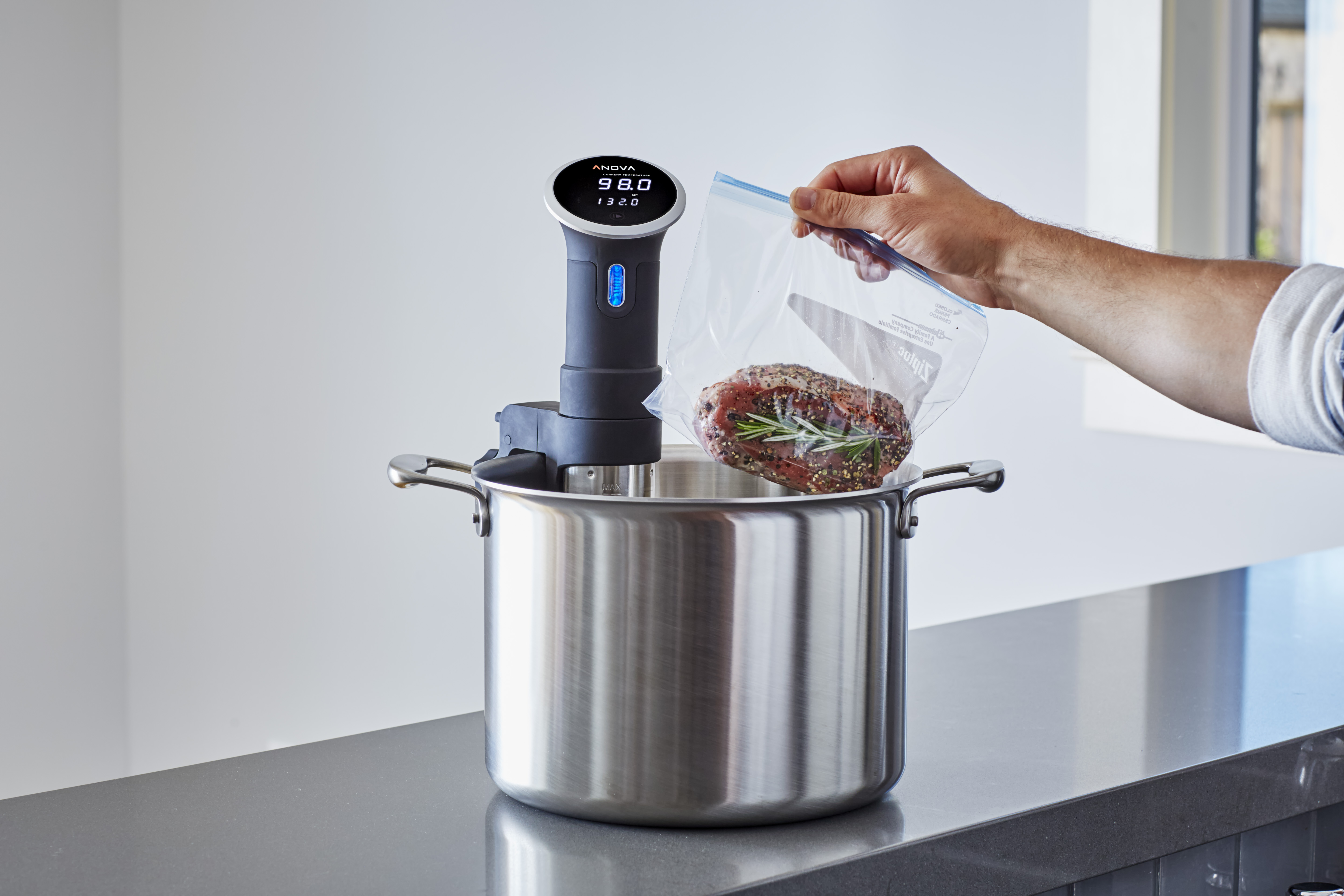I suppose you could say that I was early to the sous vide game; I became aware of sous vide in general, and immersion circulators specifically, by watching Food Network — one of my few television indulgences. I loved the concept, and I loved that there were companies coming onto the scene that were bringing the established professional cooking method to the home. So almost exactly three years ago now, I bought into it myself — with the Anova Precision Cooker. Now a few years in, I thought it’d be a good time to look back at this “wonder appliance.”
If you’re not familiar with sous vide cooking, briefly, you place something you want to cook in a plastic bag, remove the air (either by pressing it out, or using a vacuum sealer; sous vide means under vacuum), immerse it in a pot of water (remember the old Seal-a-Meal boil-in-bag concept?), which (unlike boil-in-bag) is then brought to and held at a precise temperature by an immersion circulator appliance.
Want a medium rare steak? Set the device for 138ºF, drop your plastic-bag-sealed steak into the water bath, and let it sit there for an hour-ish, and it’s cooked to that exact temperature.
Why would you do this?
- You can cook to exact temperature. If you like your protein (chicken, beef, etc.) to cooked to a precise temperature, you can have it — and it’s exactly correct, every time. No guess work, and no under- or over-cooking. Ever.
- It’s flexible and easy. Cooking charts are available that show the minimum time needed in the water bath to achieve a full cook (bringing it to temperature clear to the center of the food), but if you shoot past the target time, no biggie. You literally cannot overcook anything. (If you leave it in the water bath way too long, the texture can begin to change, so you don’t want to leave it indefinitely, but you also don’t have to plan your cooking so precisely. The charts referenced above have range information showing minimum [for doneness] and maximum [to prevent texture change] details. Remember too that minimum time is dependent on the thickness of the food being cooked.)
- The results can be pretty amazing. If you like the high protein, low fat benefits of a chicken breast, you’ll find no more unctuous, enjoyable, moist and delightful way to have one than sous vide preparation.
You have to bear in-mind that sous vide provides no carmelization, so once the cooking is done, in most cases, you’ll sear what you’ve cooked over very high heat for a short period to give the exterior the appearance and appeal you expect from a steak, piece of fish, piece of chicken, etc. But that part is easy and fast; you’re not actually cooking it at that point, you’re just making it look and taste like a conventionally-prepared piece of meat.
Meat proteins are, in my view, the best use of the Anova immersion circulator, or indeed any sous vide device. You can also cook eggs with remarkable accuracy, but I just don’t really see the point of that — or the point of cooking vegetables and so forth when so many other better, faster, simpler ways exist.
The Anova Precision Cooker
In any case, now that I’m three or so years into my Anova experience, I have to say, I have no regrets. It’s a simple, easy-to-use, affordable (roughly $100) way to add precision cooking to your repertoire, the results are predictable, consistent and enjoyable, and it just seems like anyone who enjoys cooking should have one.
The concept of the Anova is simple; it’s basically a stick-shaped appliance that attaches to a large pot (see the feature photo) or, in my case, a large, plastic food service container I bought from a restaurant supply house. Fill it with water, turn-on the Anova, set its temperature, wait for it to heat the water up, and drop-in the plastic-sealed food.
The Anova circulates the water with an impeller, warming it using the built-in heating coil. The concept is simple, the appliance is maintenance-free, and there’s just not much to it. My Anova has Bluetooth support; newer models have WiFi. Honestly, the connectivity is a gimmick. Anova has an app, and you can control the cooking with it, but so far, I’ve seen zero advantage to that. I use the cooking charts I linked-to above, I set the temp, I set a kitchen timer, and that’s that. Considering there’s nothing to monitor or change during the cook, why would you need app integration?
The only issues I’ve had with my Anova is a very tiny spot or two of rust on the supposedly stainless steel part at the very bottom, and the metal shaft coming slightly loose.
For the former, a plastic cover twists on and off the very tip to cover the impeller and direct the water stream. When you’re done with a cook, remove the Anova from the water bath, detach the plastic impeller cover, dry it completely, and you should keep that from happening (or in my case, keep it from getting worse).
For the latter, the shift is designed to twist on and off, so it just requires a twist and all is good, it’s just looser than ideal.
Anova (the company) has had some great success in the space. They’ve sold themselves to Electrolux… The product is now available in retail stores like Target (I had to order mine direct from the company when I got it)… And broader interest in the culinary arts in general has clearly benefited the company as awareness of sous vide has grown.
If you’re on the fence, it’s time to get off of it, and add sous vide cooking to your kitchen.

